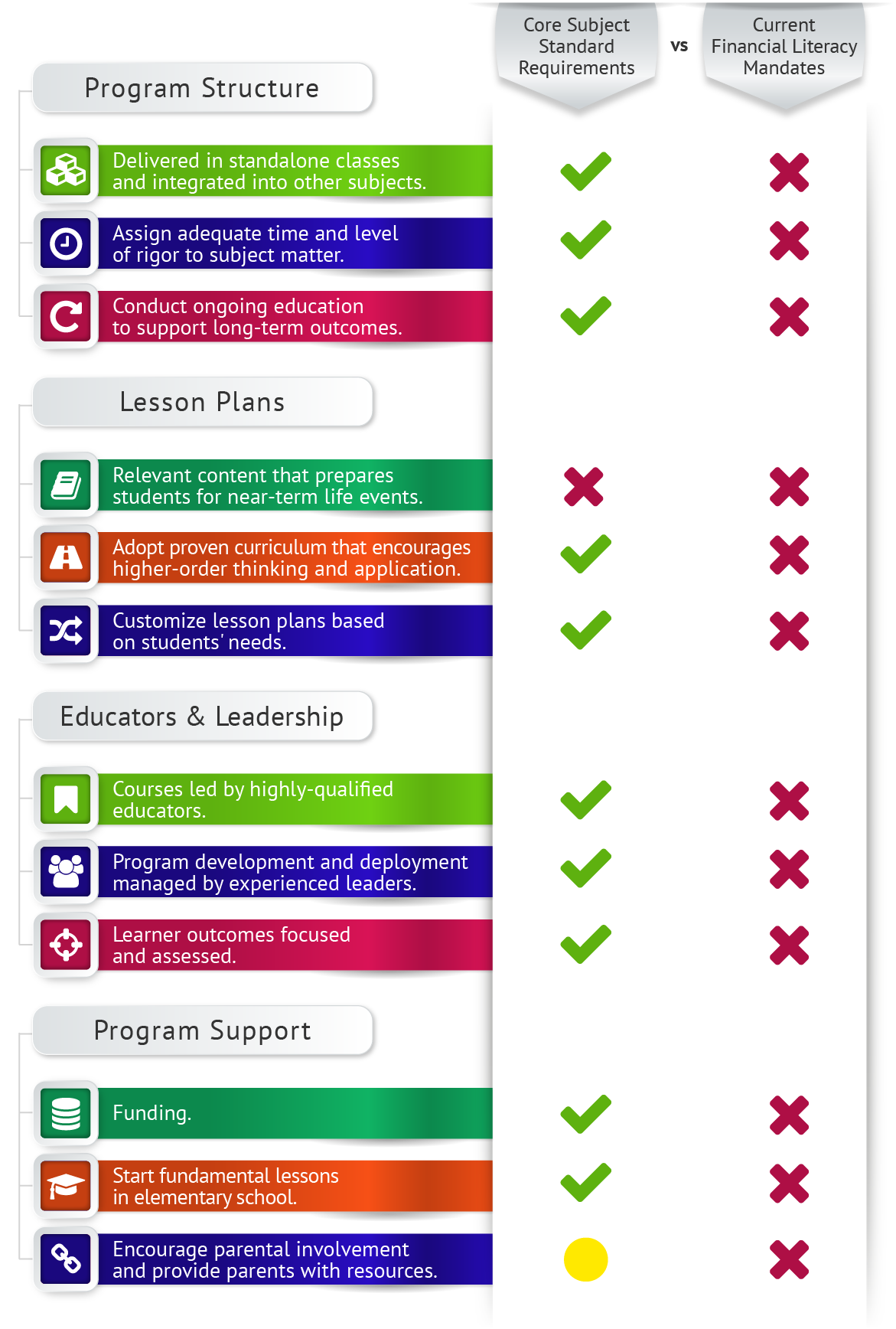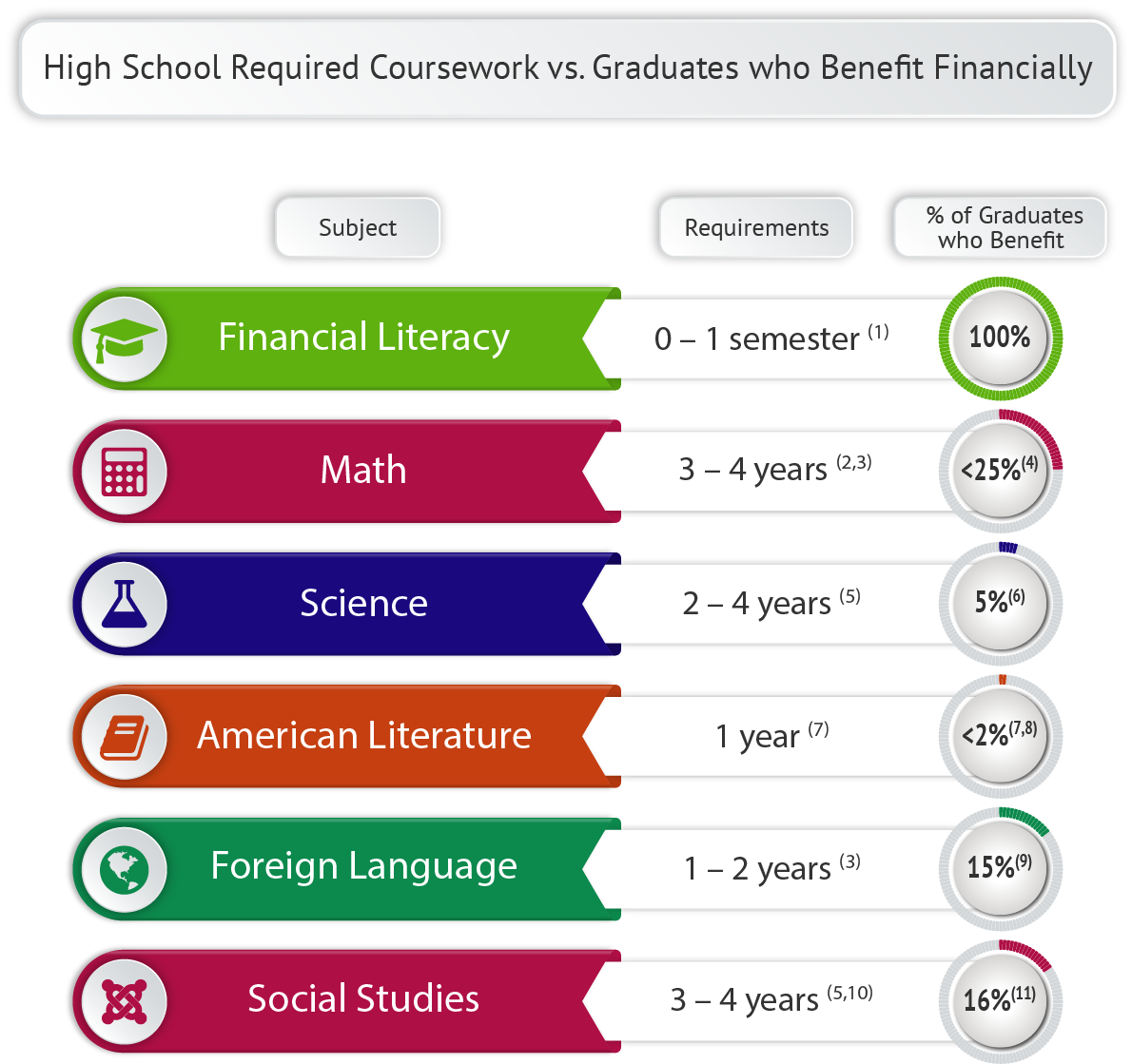Insufficient Compliance with Minimum Educational Standards Found in High School Financial Literacy Requirements Across All States
Financial education has never been needed more in the United States. According to the American Public Education Foundation, only 57% of Americans are financially literate, ranking the country 14th in the world on that metric; and four out of five U.S. adults say they were never given an opportunity to learn about personal finance.(1)
The consequences of financial illiteracy across the nation are grim: oppressive debt, lack of savings, increasing numbers of bankruptcies, little or no retirement funds. And these negative consequences spill over into people’s relationships, work and personal lives, and physical and mental health.
Even with the severe long-term consequences and the major risk this issue poses to youth – schools fail to teach financial literacy in accordance with the minimum standards required by other core topics mandated in schools.
All State Mandated Financial Literacy Programs Fail to Meet Basic Educational Standards
Financial Education Programs Benefit More Students with Necessary Information
According to recent studies (2, 3), a limited proportion of students reap financial benefits from their high school coursework, underscoring the potential significance of integrating financial literacy education into the curriculum. By equipping graduates with essential financial knowledge and skills, financial literacy can directly contribute to their personal well-being.(3)
New Guidelines Introduce Fundamental Standards for High School Financial Education
Educational standards have been laid out for the rest of the core curriculum most students receive, but not yet for financial education – a topic that would benefit 100% of American children and teens.
Even with more states adopting financial literacy, we have yet to provide schools – even those schools that do offer financial education to students – with guidance regarding the optimal content, rigor, and educator preparation for teaching personal finance. Financial education for grades K-12 needs a framework that sets forth standards for program quality and rigor, teacher qualifications, and testing. Such guidelines have been in place for traditional subjects since the 1980s, as described in the following section.
The National Financial Educators Council is working to address this gap. We developed the first standards that mandate financial education at all grade levels K-12 and set benchmarks for program rigor, teacher qualification, and evaluation measures to quantify impact. Now we are advocating to encourage adoption of these standards nationwide.
Current Subjects Required in Most States
The traditional high school curriculum covers Math, Science, Social Studies, English, Foreign Language, and some form of Arts. That was true in 1920, and it’s still true today. Our question is: how well did high school prepare young Americans to enter the workforce in eras gone by, and to what extent – if any – has that life preparedness changed across the years?
You probably know that the prevalent occupations during many of the last 10 decades were very different from the careers available today. And you’re also aware that our schools have always been charged with preparing young people to become independent adults, ready to enter the workforce and face the challenges of the real world.
So why have Americans been studying the identical subject matter in high school for more than a century? And why are we not teaching personal finance?
English Language Arts
Almost all US states require 4 years of English/Language Arts for high school graduation. The exceptions are California, which requires 3; Idaho, which requires 4.5; Colorado and Massachusetts, which allow individual districts to establish graduation requirements; and Maine and Vermont, which have adopted proficiency-based standards.(4)
History/Social Studies
The usual Social Studies requirement for high school graduation in the US is 3 years. Eight states require 4 years; three states require just 2 years; Idaho and New Hampshire require 2.5 years; and Minnesota and New Mexico require 3.5 years. Massachusetts and Pennsylvania leave the decision to local school districts, while Maine and Vermont use proficiency-based standards.(4, 5) Typical course requirements include US, world, and specific state history; civics and/or government; and in some cases, geography.
Science/Technical Subjects
A majority (34) of US states require 3 years of Science for high school graduation. Five states require 4 years of Science instruction; a further seven states require just 2 years. Colorado, Maine, and Pennsylvania leave the decision to local school districts. Maine and Vermont have adopted proficiency-based standards.(4 Education Commission) Among specific courses, Biology is the top requirement among US states, with several states listing “lab sciences” as specific courses required. Other common courses include Physical Science, Chemistry, and Physics. In a few states, Computer Science or Engineering can be substituted for one of the other course requirements.
Mathematics
Nearly all (45) US states require at least 3 years of Mathematics for high school graduation, and 17 states plus the District of Columbia require 4. Only California and Montana require less (2 years). Maine and Vermont use proficiency-based standards; while Massachusetts and Pennsylvania charge local school districts with determining the Math graduation requirements.(4 Education Commission) Notably, all states that specify Math standards for high school graduation require Algebra as at least one of the course units.
Foreign Language
As of 2019, many states have removed the Foreign Language requirement for high school graduation. However, a 2-year Foreign Language requirement remains in six states, two of which (Louisiana and Michigan) require that the 2 units be taken in the same language; and New Jersey requires 1 year of world language or demonstrated proficiency. Eighteen states require 1-3 units which may be chosen from among Career and Technical Education (CTE), Foreign Language, Arts Education, or Visual/Performing Arts. Two states (Colorado and Massachusetts) leave the decision at the local district level.(4 Education Commission)
Addressing the Gap
To address the gap in standards for personal finance education, the National Financial Educators Council has developed a set of benchmarks for all grade levels, K-12. This standards guide offers schools a yardstick by which to evaluate program rigor, teacher qualifications, and testing measures to quantify impact. The goal is to lay out a framework that standardizes educational quality and learner outcomes to provide the best possible financial education for American youth.
The Standards Guide is based on the notion that financial education should be treated the same as any other topic taught in schools. That means the subject should be held to the same standards of rigor, pedagogy, and measurement as all other curriculum material. Thus the standards cover 11 areas:
1) Qualified leaders head program development and deployment.
2) Financial education is presented as a standalone program with added integration into other subjects.
3) Time taught and rigor of material.
4) Highly-qualified personal finance educators.
5) Learner outcomes focus on long-term financial wellness and early indicators.
6) Implement curriculum that balances research-based educational methodologies with practical application.
7) Encourage parental involvement and give parents access to resources.
8) Relevant content that prepares students for near-term financial life events.
9) Differentiation by socioeconomic status.
10) Conduct ongoing education to support long-term behavior change.
11) Fund financial literacy programs.




